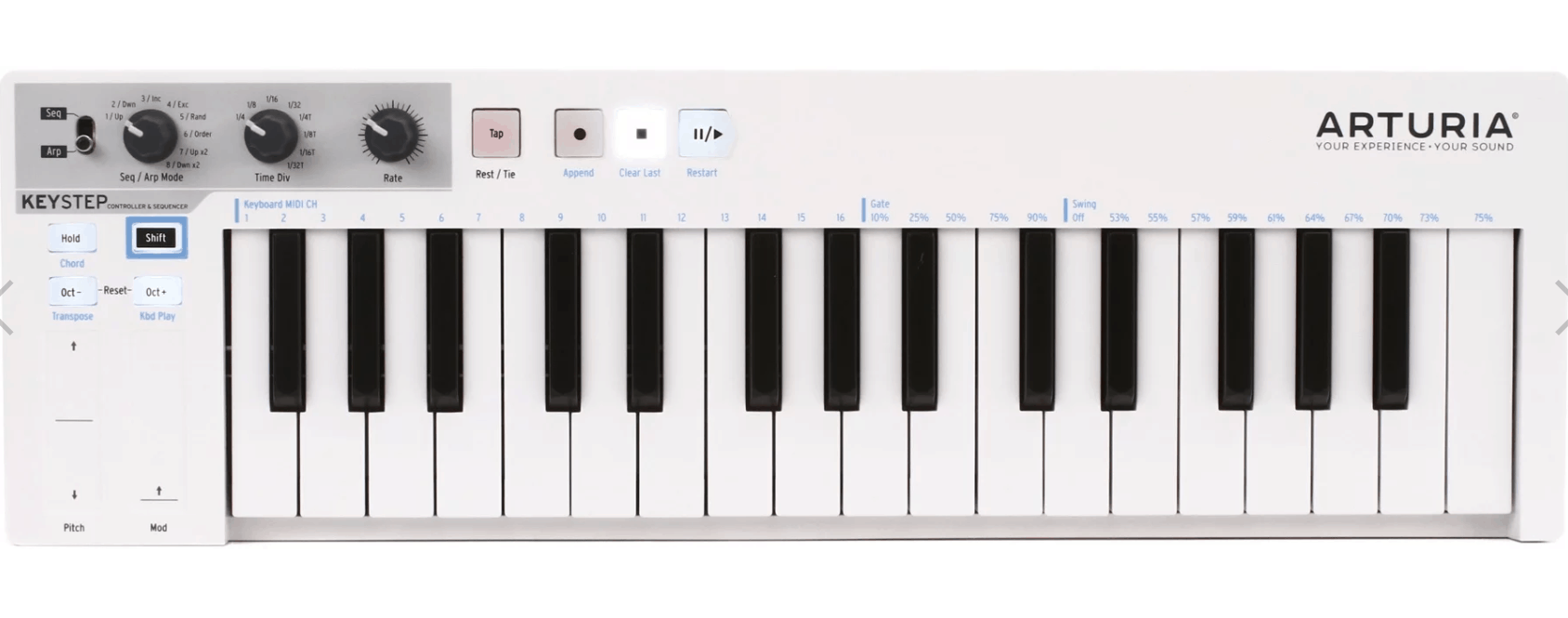Table of Contents
The Arturia Keystep is a no-frills, low-cost sequencer. It performs effectively at a fraction of the price of some of the leading models on the market. Undoubtedly, this means a few costs cut here and there and mostly in the form of component sourcing and materials used.
That said, the build is still remarkably sound, so you should get a good few years of wear and tear out of her before she needs an upgrade. If you are starting a home set-up on a frugal budget and are after a sequencer, then the Keystep is a great starting point.
It offers a 32-key key-bed with slim keys. If you are a pianist, you may want to opt for something with full-size keys, so your natural playing isn't impeded by the more compact spacing between an octave. The 32 keys give you a decent musical range to play with, spanning almost 3 octaves without using the transpose buttons. Suffice to say there are many people out there producing on a 25-key MIDI controller, so this could even be a step-up for some.
They aren't weighted like a higher-end model, but the hammer response is pretty realistic. They are velocity-sensitive and do provide a reasonable response. The transpose can shift your keys 4 octaves up or down.
They utilize the industry's Aftertouch processing, which makes them a little more natural-sounding when used as a MIDI device. The data sent captures the pressure length, which is vital for making virtual instruments sound less synthetic. At the right-hand side of the key-bed in the place of wheels are two ribbon touch-strip controllers to use for your pitch bend and modulation needs.
It is not your average MIDI controller. You can't use it to map your DAW functions like many MIDI remotes. The first 16 notes typically function as channels. When hooked-up as a MIDI device, you can open her up to use as an 8-note, polyphonic step sequencer working with 64-steps.
The functions have been kept very minimal, but extra are available via the shift button, giving you a subset of controls for each control, another thing that helps keep the footprint of this sequencer compact.
You have a toggle switch that allows you to select between the sequencer and arpeggiator and three dials. The first dial is to control the built-in arpeggiator with eight interesting patterns. As well as your average up/down sequences, there are convergence, divergence, and random patterns available. You can use the order mode to form your own.
You can overwrite the programmed 8-note patterns and save them in the MIDI control center software. You can create sequences by entering the notes one step at a time, or you can do this in real-time, with the record function, if you are confident enough. You can enter rest and note-ties with the tap button. You also have a time division and rate dial that allows you to alter patterns.
Another cool feature is the chord capture, using Shift and Hold. You can play up to 16 notes as a chord, which it will remember. You can then use a one-note chord function and play it up or down the keys. You can also send the chord to the arpeggiator, which can be chaotic.
It has a good range of I/O, most importantly the 3 x CV outs that you don't typically get with a budget option. They grant it a little more versatility, allowing for exterior expansion. There is also a Sync in/out, a MIDI in/out, and a USB. You can also connect a sustain pedal if you wish.
Arturia Keystep

Summary
The Arturia Keystep is, in essence, a 3 for 1 deal. You get a keyboard controller-come-sequencer with an integrated arpeggiator to boot. It has a simple layout, provides 32 velocity-sensitive keys to play with, and can shift 4 octaves either end of the spectrum. Despite not being a conventional DAW remote, it is a useful MIDI tool for your home set-up.
The sequencing capabilities are very simplified. The patterns are interesting, as they can be overwritten completely, or tweaked in real-time into complex rhythms, utilizing the rests and ties.
Pros
+ 32 slim keys with velocity sensitivity and Aftertouch.
+ Integrated arpeggiator with 8 settings.
+ Polyphonic step-sequencing, 8 x 64.
+ Compact and portable.
+ Versatile input/outputs.
+ MIDI Control Center Software.
+ Budget-friendly.
Cons
- It doesn't control your average DAW functions remotely.
Why We Like It
It is a simple, low-cost tool for your step-sequencing needs. You can keep all of the sequencing functions to the minimum, which makes it a great beginner's tool, although we also think it could find pride of place at the center of an experienced users rig too - if they needed something low-cost to throw around or travel with.
If you liked the article, please leave your feedback.
